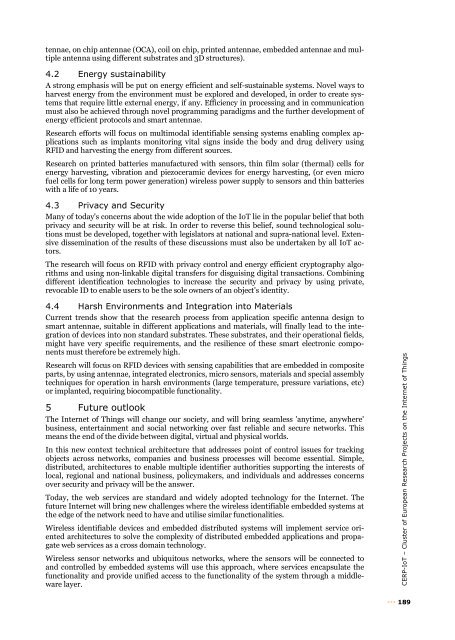Vision and Challenges for Realising the Internet of Things
Vision and Challenges for Realising the Internet of Things
Vision and Challenges for Realising the Internet of Things
You also want an ePaper? Increase the reach of your titles
YUMPU automatically turns print PDFs into web optimized ePapers that Google loves.
tennae, on chip antennae (OCA), coil on chip, printed antennae, embedded antennae <strong>and</strong> multiple<br />
antenna using different substrates <strong>and</strong> 3D structures).<br />
4.2 Energy sustainability<br />
A strong emphasis will be put on energy efficient <strong>and</strong> self-sustainable systems. Novel ways to<br />
harvest energy from <strong>the</strong> environment must be explored <strong>and</strong> developed, in order to create systems<br />
that require little external energy, if any. Efficiency in processing <strong>and</strong> in communication<br />
must also be achieved through novel programming paradigms <strong>and</strong> <strong>the</strong> fur<strong>the</strong>r development <strong>of</strong><br />
energy efficient protocols <strong>and</strong> smart antennae.<br />
Research ef<strong>for</strong>ts will focus on multimodal identifiable sensing systems enabling complex applications<br />
such as implants monitoring vital signs inside <strong>the</strong> body <strong>and</strong> drug delivery using<br />
RFID <strong>and</strong> harvesting <strong>the</strong> energy from different sources.<br />
Research on printed batteries manufactured with sensors, thin film solar (<strong>the</strong>rmal) cells <strong>for</strong><br />
energy harvesting, vibration <strong>and</strong> piezoceramic devices <strong>for</strong> energy harvesting, (or even micro<br />
fuel cells <strong>for</strong> long term power generation) wireless power supply to sensors <strong>and</strong> thin batteries<br />
with a life <strong>of</strong> 10 years.<br />
4.3 Privacy <strong>and</strong> Security<br />
Many <strong>of</strong> today's concerns about <strong>the</strong> wide adoption <strong>of</strong> <strong>the</strong> IoT lie in <strong>the</strong> popular belief that both<br />
privacy <strong>and</strong> security will be at risk. In order to reverse this belief, sound technological solutions<br />
must be developed, toge<strong>the</strong>r with legislators at national <strong>and</strong> supra-national level. Extensive<br />
dissemination <strong>of</strong> <strong>the</strong> results <strong>of</strong> <strong>the</strong>se discussions must also be undertaken by all IoT actors.<br />
The research will focus on RFID with privacy control <strong>and</strong> energy efficient cryptography algorithms<br />
<strong>and</strong> using non-linkable digital transfers <strong>for</strong> disguising digital transactions. Combining<br />
different identification technologies to increase <strong>the</strong> security <strong>and</strong> privacy by using private,<br />
revocable ID to enable users to be <strong>the</strong> sole owners <strong>of</strong> an object's identity.<br />
4.4 Harsh Environments <strong>and</strong> Integration into Materials<br />
Current trends show that <strong>the</strong> research process from application specific antenna design to<br />
smart antennae, suitable in different applications <strong>and</strong> materials, will finally lead to <strong>the</strong> integration<br />
<strong>of</strong> devices into non st<strong>and</strong>ard substrates. These substrates, <strong>and</strong> <strong>the</strong>ir operational fields,<br />
might have very specific requirements, <strong>and</strong> <strong>the</strong> resilience <strong>of</strong> <strong>the</strong>se smart electronic components<br />
must <strong>the</strong>re<strong>for</strong>e be extremely high.<br />
Research will focus on RFID devices with sensing capabilities that are embedded in composite<br />
parts, by using antennae, integrated electronics, micro sensors, materials <strong>and</strong> special assembly<br />
techniques <strong>for</strong> operation in harsh environments (large temperature, pressure variations, etc)<br />
or implanted, requiring biocompatible functionality.<br />
5 Future outlook<br />
The <strong>Internet</strong> <strong>of</strong> <strong>Things</strong> will change our society, <strong>and</strong> will bring seamless 'anytime, anywhere'<br />
business, entertainment <strong>and</strong> social networking over fast reliable <strong>and</strong> secure networks. This<br />
means <strong>the</strong> end <strong>of</strong> <strong>the</strong> divide between digital, virtual <strong>and</strong> physical worlds.<br />
In this new context technical architecture that addresses point <strong>of</strong> control issues <strong>for</strong> tracking<br />
objects across networks, companies <strong>and</strong> business processes will become essential. Simple,<br />
distributed, architectures to enable multiple identifier authorities supporting <strong>the</strong> interests <strong>of</strong><br />
local, regional <strong>and</strong> national business, policymakers, <strong>and</strong> individuals <strong>and</strong> addresses concerns<br />
over security <strong>and</strong> privacy will be <strong>the</strong> answer.<br />
Today, <strong>the</strong> web services are st<strong>and</strong>ard <strong>and</strong> widely adopted technology <strong>for</strong> <strong>the</strong> <strong>Internet</strong>. The<br />
future <strong>Internet</strong> will bring new challenges where <strong>the</strong> wireless identifiable embedded systems at<br />
<strong>the</strong> edge <strong>of</strong> <strong>the</strong> network need to have <strong>and</strong> utilise similar functionalities.<br />
Wireless identifiable devices <strong>and</strong> embedded distributed systems will implement service oriented<br />
architectures to solve <strong>the</strong> complexity <strong>of</strong> distributed embedded applications <strong>and</strong> propagate<br />
web services as a cross domain technology.<br />
Wireless sensor networks <strong>and</strong> ubiquitous networks, where <strong>the</strong> sensors will be connected to<br />
<strong>and</strong> controlled by embedded systems will use this approach, where services encapsulate <strong>the</strong><br />
functionality <strong>and</strong> provide unified access to <strong>the</strong> functionality <strong>of</strong> <strong>the</strong> system through a middleware<br />
layer.<br />
CERP-IoT – Cluster <strong>of</strong> European Research Projects on <strong>the</strong> <strong>Internet</strong> <strong>of</strong> <strong>Things</strong><br />
189
















